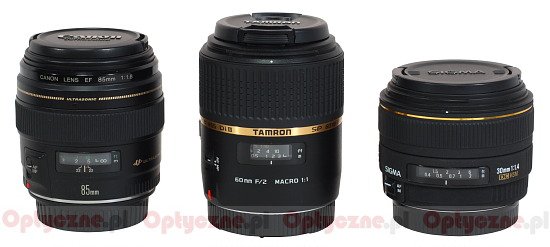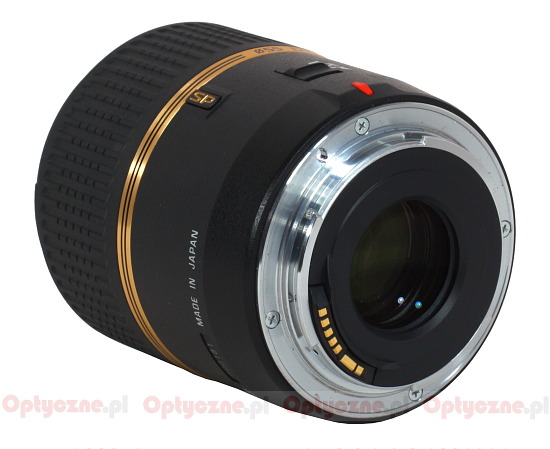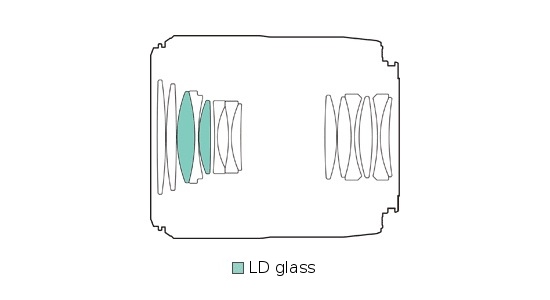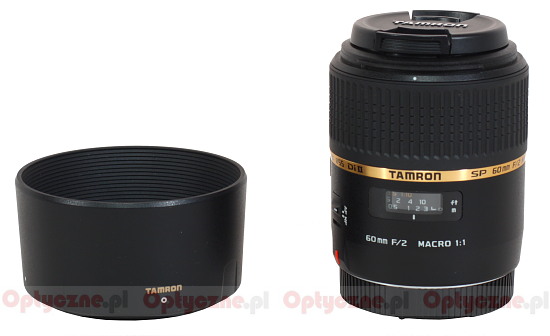Tamron SP AF 60 mm f/2.0 Di II LD (IF) Macro 1:1
3. Build quality
The picture below shows the tested lens between the Canon EF 1.8/85 and the Sigma 1.4/30.
 |
Please Support UsIf you enjoy our reviews and articles, and you want us to continue our work please, support our website by donating through PayPal. The funds are going to be used for paying our editorial team, renting servers, and equipping our testing studio; only that way we will be able to continue providing you interesting content for free. |
- - - - - - - - - - - - - - - - - - - - - - - - - - - - - - - - - - - - - - - - - - - - - - - -
The Tamron SP AF 60 mm f/2.0 Di II LD (IF) Macro 1:1 starts with a metal bayonet mount inside which you can find an immobile element 27 mm in diameter. Behind the mount there is a barrel padded with black, smooth plastics. You can see a red marking showing the right position for attaching the lens to a body, an inscription with the name of the lens and its parameters and, above it, a distance scale expressed in feet and meters behind a window; unfortunately there are no depth of field markings. Instead we get a magnification scale with the markings from 1:1 to 1:10. On the left we have a focusing mechanism mode switch (AF/MF) and a serial number of the lens and information that it was produced in Japan behind.
 |
The smooth part of the barrel ends with a golden stripe on which you can find the full name of the lens and its parameters. Most of the remaining part is occupied by a manual focus ring, 3 cm wide, with thick rubberized ribs which are supposed to facilitate its usage. Unfortunately this ring is still far from perfect. It often happens than a slight turn doesn’t cause any shift of the distance scale – such slacks are very annoying when you care about precise work. Running through the whole scale takes a 250-degree turn. Regrettably the producer didn’t decide to include an autofocus limiter, so popular in macro lenses nowadays.
Immediately after the manual focus ring we find a lens hood mount. At the front of the lens we have an immobile element 4 cm in diameter, which is surrounded by a non-rotating filter thread, 55 mm in diameter.
As the front and the rear element are immobile the focusing is performed by the shift of inner optical elements inside the lens’s construction. Such a solution has obvious advantages – the lens keeps its dimensions unchanged and it is fully sealed. You should remember, though, that it also involves a change of focal length. Working near 1:1 magnification scale the lens is f/4.0 or so fast and its focal length is shorter than those declared 60 mm. The producer claims that the lens’s minimum focus distance is 23 cm. It’s also worth remembering that this value concerns the distance to the main plane of the lens. In real life usages the distance from the front element is more important and while working in the 1:1 scale it amounts to about 10 cm.
 |
The Tamron 2/60 is a relatively complicated construction. It consists of 14 elements positioned in 10 groups and two of them were made of low-dispersion LD glass. For comparison the Canon EF-S 2.8/60 doesn’t feature any special glass and the full frame Nikkor 2.8/60 boasts just one ED element but also two aspherical elements for a change. Inside the Tamron we can also find an aperture with seven diaphragm blades which can be closed down to f/22.
The buyer gets both caps and a hood included in box.
 |






